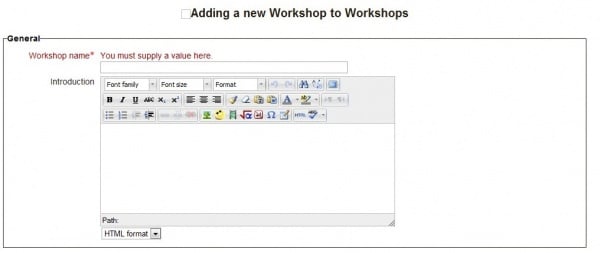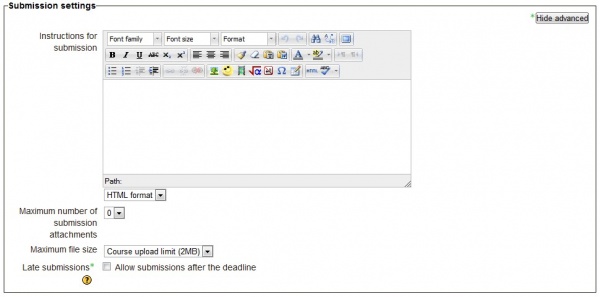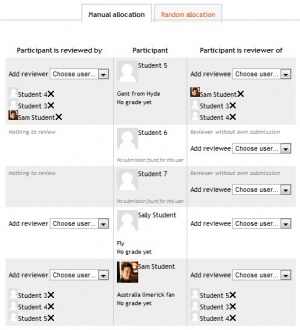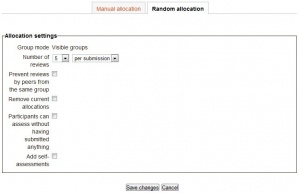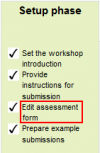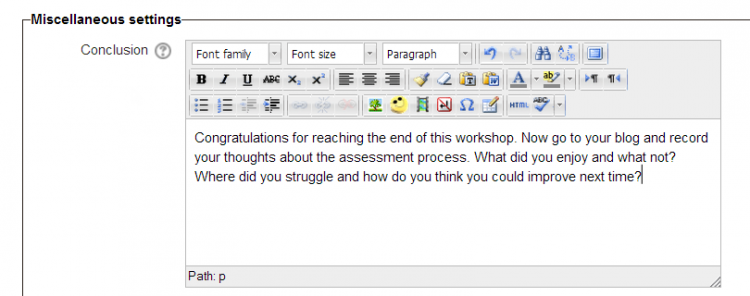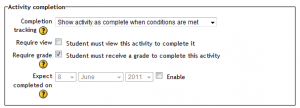Workshop settings: Difference between revisions
Joanna Phoon (talk | contribs) |
Mary Cooch (talk | contribs) (copied from 2.3 docs) |
||
| (11 intermediate revisions by 4 users not shown) | |||
| Line 1: | Line 1: | ||
{{Workshop}} | {{Workshop}} | ||
Here are the workshop configuration settings. These will appear when adding a workshop activity for the first time to a course, or when the editing teacher selects | Here are the workshop configuration settings. These will appear when adding a workshop activity for the first time to a course, or when the editing teacher selects ''Settings > Workshop Administration > Edit settings'' link. | ||
==General== | ==General== | ||
| Line 8: | Line 8: | ||
To add a new workshop to a course, the teacher has to follow the steps: | To add a new workshop to a course, the teacher has to follow the steps: | ||
# | #With the editing turned on, in the section you wish to add your workshop, click the "Add an activity or resource" link (or, if not present, the "Add an activity" drop down menu )and choose ''Workshop.'' | ||
# The "Adding a new workshop" form will be displayed [[File:new_workshop_form.jpg |thumb|none|upright=2.0|alt="The form shown when adding a new workshop" | The form for new workshops]] | # The "Adding a new workshop" form will be displayed [[File:new_workshop_form.jpg |thumb|none|upright=2.0|alt="The form shown when adding a new workshop" | The form for new workshops]] | ||
# Enter the Workshop Name and give a description of the workshop in the “Introduction” field. | # Enter the Workshop Name and give a description of the workshop in the “Introduction” field. | ||
| Line 24: | Line 23: | ||
'''Updating a Workshop''' | '''Updating a Workshop''' | ||
To update a workshop | To update a workshop simply make sure that you are in Editing Mode and then click on the update workshop button, represented by two arrows facing opposite directions. Most of the settings mentioned in "Adding a Workshop" will be available for change but please note some features may only be changed during the setup phase. This is mentioned in detail in each of the sub-sections | ||
==Workshop features== | ==Workshop features== | ||
* '''Examples:'''<br clear="all"/> | * '''Examples:'''<br clear="all"/> | ||
Students can assess example submissions for practice before assessing their peers' work if this feature is enabled. They can compare their assessments with reference assessments made by the teacher. The grade will not be counted in the grade for assessment. | |||
Teachers need to upload one or more example submissions and the corresponding reference assessment to support this function: | Teachers need to upload one or more example submissions and the corresponding reference assessment to support this function: | ||
| Line 179: | Line 178: | ||
*'''Clear assessments:''' | *'''Clear assessments:''' | ||
By clicking this button, grades for assessments along with grades for submission will be reset. The assessment form will remain the same but all the reviewers need to open the assessment form again and re-save it to get the given grades calculated again. | By clicking this button, grades for assessments along with grades for submission will be reset. The assessment form will remain the same but all the reviewers need to open the assessment form again and re-save it to get the given grades calculated again. | ||
==Miscellaneous settings== | |||
====Conclusion==== | |||
{{New features}} | |||
It is possible to add some custom text which the students will see once they reach the end of the workshop process. This might be a general summary or suggestions on what should be done next, such as writing a blog post to reflect on the experience. | |||
[[File:workshopconclusion.png|thumb|none|upright 2.5|alt="Conclusion"|Workshop conclusion]] | |||
==Access control== | ==Access control== | ||
The whole of this section falls under the category of “Advanced Settings”. Without having clicked the “Show Advanced” button there are no options under the access control section. | The whole of this section falls under the category of “Advanced Settings”. Without having clicked the “Show Advanced” button there are no options under the access control section. | ||
[[File:Access_control.jpg|thumb|none|upright 2.5|alt="The Access Control Menu" | Access Control Section]] | |||
Access Control deals with setting submission times and assessment times for the workshop. That is the time when students can start submitting as well as the deadline for submitting, and similarly the time assessments for other students’ work start and when they must finish assessing other students work. | Access Control deals with setting submission times and assessment times for the workshop. That is the time when students can start submitting as well as the deadline for submitting, and similarly the time assessments for other students’ work start and when they must finish assessing other students work. | ||
[[ | All access control dates - open for submissions from, submissions deadline, open for assessment from and assessment deadline - are displayed in the course [[Calendar|calendar]]. | ||
Access control lets teacher decide if they want a workshop with a closed schedule or one that is open ended. Setting an opening time but leaving the deadline open makes it an ongoing activity. To set the opening time and deadline for either submissions or assessments teachers must click the enable button next to the option they want to set. Once the enabled has been checked the 5 drop down boxes will be activated and available for change. | Access control lets teacher decide if they want a workshop with a closed schedule or one that is open ended. Setting an opening time but leaving the deadline open makes it an ongoing activity. To set the opening time and deadline for either submissions or assessments teachers must click the enable button next to the option they want to set. Once the enabled has been checked the 5 drop down boxes will be activated and available for change. | ||
| Line 191: | Line 199: | ||
The first three boxes correspond to the date and we can either set this box by box or by selecting the date in the calendar that pops up when any of the date boxes are selected. | The first three boxes correspond to the date and we can either set this box by box or by selecting the date in the calendar that pops up when any of the date boxes are selected. | ||
The last two boxes correspond to the time in 24 hour time, the first of the two being hours and the second being minutes. Teachers simply set the desired time for each of the sections they wish to activate. | The last two boxes correspond to the time in 24 hour time, the first of the two being hours and the second being minutes. Teachers simply set the desired time for each of the sections they wish to activate. | ||
If teachers check the box "''switch to the next phase after the submissions deadline"'', the workshop will automatically switch to the assessment phase after the next cron job. (Note that since MDL-37781, the phase switching no longer requires cron to be executed. This will apply to your Moodle if it is the latest weekly after February 8th, or if it is Moodle 2.4.2 onwards.) | |||
==Common module settings== | ==Common module settings== | ||
| Line 245: | Line 255: | ||
* '''Expect completed on:''' | * '''Expect completed on:''' | ||
If this setting is enabled, it will specify the date when the activity is expected to be completed. The date will not be shown to students and will only be displayed in the activity completion report. | If this setting is enabled, it will specify the date when the activity is expected to be completed. The date will not be shown to students and will only be displayed in the activity completion report. | ||
==Site administration settings== | |||
The workshop module has additional settings which may be changed by an administrator in ''Settings > Site administration > Plugins > Activity modules > Workshop''. The settings enable default values to be set for all edit workshop settings. | |||
==See also== | |||
* http://rubistar.4teachers.org/ - a free tool to help teachers create rubrics | |||
[[de:Workshop konfigurieren]] | |||
Latest revision as of 15:52, 12 February 2013
Here are the workshop configuration settings. These will appear when adding a workshop activity for the first time to a course, or when the editing teacher selects Settings > Workshop Administration > Edit settings link.
General
Adding a Workshop
To add a new workshop to a course, the teacher has to follow the steps:
- With the editing turned on, in the section you wish to add your workshop, click the "Add an activity or resource" link (or, if not present, the "Add an activity" drop down menu )and choose Workshop.
- The "Adding a new workshop" form will be displayed
- Enter the Workshop Name and give a description of the workshop in the “Introduction” field.
- Choose the Workshop features, more details in Workshop Features
- Choose the Grading Settings, for more details on this refer to the sub-section Grading Settings
- Choose the Submission Settings, for more details on this refer to the sub-section Submission Settings
- Specify the Assessment Settings, for more details on this refer to the sub-section Assessment Settings
- Specify the Access Control, this deals with when the workshop is open for submission and assessment, for more details refer to the sub-section Access Control
- Choose the Common Module Settings, for more details on this refer to the sub-section Common Module Settings
- Finally set the Restrict Access settings as well as Activity Completion. After completing this the teacher can also set any advanced settings they wish to do. For more details simply refer to the Restrict Access and Activity Completion sub-sections.
Updating a Workshop
To update a workshop simply make sure that you are in Editing Mode and then click on the update workshop button, represented by two arrows facing opposite directions. Most of the settings mentioned in "Adding a Workshop" will be available for change but please note some features may only be changed during the setup phase. This is mentioned in detail in each of the sub-sections
Workshop features
- Examples:
Students can assess example submissions for practice before assessing their peers' work if this feature is enabled. They can compare their assessments with reference assessments made by the teacher. The grade will not be counted in the grade for assessment.
Teachers need to upload one or more example submissions and the corresponding reference assessment to support this function:
- Click the ‘Add example submission’ button in the first page of the workshop setup for the assignment.
- Click the ‘continue’ button and provide a corresponding reference assessment based on the assessment form. If you fail to provide corresponding reference assessment, you can assess the example submissions later by clicking ‘assess’ button in the first page of the workshop setup. Also, unassessed example submissions will be highlighted in pink by the Moodle system.
- Teachers can also edit the reference assessment later by clicking the ‘re-assess’ button in the first page.
- Peer assessment:
If this feature is enabled, a student will be allocated a certain amount of submissions from his peers to assess. He will receive a grade for each assessment, which will be added together with the grade for his own submission and this will be used as his final grade for this assignment.
This is the key feature of workshop: To encourage students to assess the work of their peers and learn from each other. Through this, they will see the strengths of their classmates’ submissions and have a better understanding about how to do a good job. In addition, the advices they get from their peers will give them a more comprehensive view of their own work: The comments from their peers will point out the weakness of their work, which is generally difficult to find out by themselves.
- Self-assessment:
If this option is turned on, a student may be allocated his own work to assess. The grade he receives from assessment of his own work will be counted into the grade for assessment, which will be added together with the grade for submission and used to calculate his final grade for this assignment.
This setting enables teachers to see whether students can find out the strength and weakness of their own submissions and judge them objectively. It is a good way to help students think more comprehensively.
Grading settings
There are three settings in this section in the basic mode but with the click of the “Show Advanced” button there is one additional option. This button is found in the top right hand corner of the Grading Settings section of the form.
- Grade for Submission: This sets the maximum grade a student can attain from a teacher for a given submission. It is scaled between 0-100
- Grade for Assessment: Sets the maximum grade a student can receive for assessing other students’ work. It is also scaled between 0-100
Grading Strategies
The grading strategy chosen here determines the assessment form students will use and this method is also used for grading submissions. Please note that the descriptions of the grading strategies given are just summaries, for a detailed description refer to the page Grading Strategies.
- Accumulative grading: Comments and a grade are given regarding the aspects of the workshop specified.
- Comments: Comments are given but no grade can be given to the specified aspects
- Number of Errors: A yes/no assessment is used and comments are given for specified assertions
- Rubric: A level assessment is given regarding specified criteria
To select the grading strategy simply select one of the four options from the drop down menu.
The only advanced setting given for grading settings is the ability to set how many decimal places are allowed in the grade. By default this is 0; that is grades can only be integers. To set this simply make sure you have clicked the “Show Advanced” button and then select a number from 0-5 from the drop down menu labelled “Decimal Places in Grade” found below the menu for selecting the grading strategy.
It is important to take note of the fact that grading strategies can't be changed once we have entered the submission phase of a workshop
Submission settings
These settings are to outline to students what they must submit as well as the control what students are allowed to submit. This is regarding uploading files, the number of files they can upload and additionally the size of each file. In the advanced settings for this section teachers can also decide if they would like to allow late submission.
- Instructions for submission: Here the teacher should fill in instructions on what students must submit for the workshop submission.
- Maximum number of submission attachments: In this drop down box teachers select the number of attachments a student is allowed to upload in this workshop submission. By default it is set to 0 and teachers can allow as many as 7 attachments for a single workshop submission.
- Maximum File Size: Here teachers can control how big of a file students are allowed to upload. The range of sizes starts from 10KB to 2MB
- Late Submissions: After clicking the “Show Advanced” button in the top right of the submission settings teachers can check the box indicating the allowance of late submissions. If not checked then students must either submit before the deadline of the submission period or not at all.
Once the workshop has been made we can then set more settings relating to submissions. This is done through clicking on the menu highlighted below which is found when you click on the workshop’s link or after clicking “Save and Display” on completion of the workshop. To access the menu simply click on “Allocate Submissions”. It is highlighted in the picture by the red box.
Manual Allocation
In manual allocation menu once a student has submitted work the teacher can then choose which other students get to access their work. If the student has not submitted any work the teacher cannot assign other students to access the work. However without anything submitted the teacher can choose which students’ work this student will access.
Note that if a student has not submitted any work they can only be assigned to review other students who have submitted work and likewise other students cannot be assigned to review any student who hasn’t submitted any work.
Random Allocation
In random allocation the teacher is given 5 settings that determine how the random allocation will work.
- Number of reviews: Here the teacher picks between 0 and 30 reviews for either each submission or per reviewer. That is the teacher may choose to either set the number of reviews each submission must have or the number of reviews each student has to carry out
- Prevent Reviews: If the teacher wishes for students of the same group to never review each other’s work, as most likely it is their work too in a group submission, then they can check this box and moodle will ensure that they are only allocated other students out of their group’s work to access
- Remove current allocations: Checking this box means that any manual allocations that have been set in the Manual Allocation menu will be removed
- Can access with no submission: Having this box checked allows students to assess other students’ work without having already submitted their own work.
- Add self assessments: This options when checked make sure that as well as assessing other students’ work they must also assess their own. This is a good option to teach students how to be objective to their own work.
Assessment settings
Teachers can write instructions for assessments online. This is very useful to help students have a better understanding about the important points of a task before assessing their classmates’ submissions.
- Mode of example assessment:
By clicking the 'Show advanced' button at the upper right corner of the Assessment settings field, you can see a drop down menu named Mode of examples assessment. This setting is available only after the 'use examples' check box in the Workshop Features section has been ticked.
There are three options in this drop down menu: The first option means that the assessment of the example submission is voluntary, while the second and the third ones make it mandatory, which either requires students to assess example submissions before submitting their own work or after their own submission but before peer-assessment.
After the workshop has been made, teachers can set more settings related to assessments-Edit assessment form, Grading evaluation settings and Workshop toolbox.
Editing assessment form
In order to set the criterion for an assignment, teachers need to fill out an assessment form during the setup phase. Students can view this assessment form in the submission phase and focus on what is important about the task when working on their assignment. In the next phase-the assessment phase, students will assess their peers’ work based on this assessment form.
According to the grading strategy chosen in the grading settings, teachers will get corresponding original assessment form to edit by clicking ‘Edit assessment form’ button in the first page of the workshop setup for the assignment. The grading strategy can be one of Accumulative grading, Comments, Number of errors or Rubrics. Teachers can set each criterion in detail in the assessment form.
Grade evaluation settings
In the grade evaluation phase, teachers can do specific settings for calculation of the grade for assessments.
- Grade calculation method:
This setting determines how to calculate grade for assessments. Currently there is only one option- comparison with the best assessment. For more detail, please refer to 4.2 Grade for assessment subsection of Workshop module.
First, Comparison with the best assessment method will try to imagine what a hypothetical absolutely fair assessment would look like.
For example, a teacher uses Number of errors as grading strategy to peer-assess one assignment. This strategy uses a couple of assertions and assessors just need to check if the given assertion is passed or failed. That is, they only need to choose ‘yes’ or ‘no’ for each criterion in the assessment form. In this case, there are three assessors, Alice, Bob and Cindy. And the assessment form contains three criteria. The author will get 100% grade if all the criteria are passed, 75% if two criteria are passed, 25% if only one criterion is passed and 0% if the assessor gives ‘no’ for all three assertions. Here are the assessments they give to one certain work:
Alice: yes/yes/no
Bob: yes/yes/no
Cindy: no/yes/yes
Then the best assessment will be:
Yes/yes/no
Second, workshop will give the best assessment 100% grade. Next it will measure the ‘distance’ from other assessments to this best assessment. The farther the distance, the lower grade the assessment will receive. And Comparison of assessments setting, next to the Grade evaluation setting, will determine how quickly the grade falls down if the assessment differs from the best one.
Note: Comparison with the best assessment method will compare responses to each individual criterion instead of comparing the final grades. In the example above, all of the three assessors give 75% to the submission. However, only Alice and Bob will get 100% grade for their assessments, while Cindy will get a lower grade. Because Alice and Bob agree in individual responses too, while the responses in Cindy’s assessment are different.
- Comparison of assessments:
This setting has 5 options: very lax, lax, fair, strict and very strict. It specifies how strict the comparison of assessment should be. By using comparison with the best assessment method, all assessments will be compared with the best assessment picked up by workshop. The more similar one assessment is with the best assessment, the higher grade this assessment will get, and vice versa. This setting determines how quickly the grades fall down when the assessments differ from the best assessment.
Workshop toolbox
- Clear all aggregated grades:
Clicking this button will reset aggregated grades for submission and grades for assessment. Teachers can re-calculate these grades from scratch in Grade evaluation phase.
- Clear assessments:
By clicking this button, grades for assessments along with grades for submission will be reset. The assessment form will remain the same but all the reviewers need to open the assessment form again and re-save it to get the given grades calculated again.
Miscellaneous settings
Conclusion
New feature
in Moodle 2.4!
It is possible to add some custom text which the students will see once they reach the end of the workshop process. This might be a general summary or suggestions on what should be done next, such as writing a blog post to reflect on the experience.
Access control
The whole of this section falls under the category of “Advanced Settings”. Without having clicked the “Show Advanced” button there are no options under the access control section.
Access Control deals with setting submission times and assessment times for the workshop. That is the time when students can start submitting as well as the deadline for submitting, and similarly the time assessments for other students’ work start and when they must finish assessing other students work.
All access control dates - open for submissions from, submissions deadline, open for assessment from and assessment deadline - are displayed in the course calendar.
Access control lets teacher decide if they want a workshop with a closed schedule or one that is open ended. Setting an opening time but leaving the deadline open makes it an ongoing activity. To set the opening time and deadline for either submissions or assessments teachers must click the enable button next to the option they want to set. Once the enabled has been checked the 5 drop down boxes will be activated and available for change.
The first three boxes correspond to the date and we can either set this box by box or by selecting the date in the calendar that pops up when any of the date boxes are selected. The last two boxes correspond to the time in 24 hour time, the first of the two being hours and the second being minutes. Teachers simply set the desired time for each of the sections they wish to activate.
If teachers check the box "switch to the next phase after the submissions deadline", the workshop will automatically switch to the assessment phase after the next cron job. (Note that since MDL-37781, the phase switching no longer requires cron to be executed. This will apply to your Moodle if it is the latest weekly after February 8th, or if it is Moodle 2.4.2 onwards.)
Common module settings
By clicking the 'Show advanced' button at the upper right corner of the common moodle settings field, you will be able to see two more settings, Grouping and Available for group members only, besides Group mode, Visible and ID number in the basic mode.
- Group mode:
- No groups - There are no groups and each student of the course is a member of the same big community. The whole workshop is available to all the students of the course. All students can submit their work in one single submission area.
- Separate groups - Each group member can only submit his work within the separate group based submission area, while other groups are invisible. Teachers can sort submissions by ‘Group’ or ‘View all participants’.
- Visible groups - Each group member works within his own group. All students submit their work within the same submission area, but they can choose their own group to associate their submissions with before uploading. Unlike separate group mode, all other groups are visible but submissions of other groups are read-only. Teachers can sort submissions by ‘Group’ or ‘View all participants’.
Note: If ‘Separate group’ mode or ‘Visible group’ mode is selected, students need to be part of at least one group to get peer-assessments allocated to them by this tool. Nevertheless, students who do not belong to any groups can still be given new self-assessments or have existing assessments removed.
- Grouping:
Grouping is a cluster of groups within one course. Students assigned to groups of one grouping are able to access the workshop and work together if that grouping is selected.
This setting helps teachers a lot when they have many different topics for projects paired with different activity types. For example, there are four groups in one course: groups A, B, C and D. Groups A and B are supposed to write in a forum while groups C and D are supposed to make a wiki. The teacher can create a forum grouping containing groups A and B, and another wiki grouping containing groups C and D. Within each grouping, you have two sub-groups for an added layer of distinction.
- Available for group members only:
If this setting is enabled, only students assigned to groups within the selected grouping can access the activity or resource.
- Visible:
Teacher can choose whether to show or hide the activity or resource.
- ID number:
Each unique ID number associates with an activity, which is easier to type than the name of the activity. This setting aims at providing a way to identify an activity for grade calculation purposes. If the activity is not included in any grade calculation, then the ID number field can be left blank.
The ID number can also be set on the edit grade calculation page in the Gradebook, but it can only be edited on the update activity page of the module in a course context.
Restrict access
- Allow access from/until:
Access from/to date determines the exact period during which students can access an activity via a link on the course page. Unlike Availability Settings, outside the set dates students can not access this activity at all. However, in the case of Availability Settings, students can still view the activity description after the set period.
- Grade conditions:
This setting requires students to meet certain grade conditions before accessing the activity. Teachers can choose one particular grade condition from the drop down menu and then fill in the blanks next to the menu with the acceptable range of grade. Multiple grade conditions can be set for one single activity by clicking ‘Add 2 grade conditions to form’ button. In that case, students need to meet all the grade conditions in order to access the activity.
- Before activity can be accessed:
Teachers can decide whether they want their students to see the activity before it is available. They can choose from the drop down menu either to show the activity greyed-out with restriction information or just hide the activity entirely.
Activity completion
- Completion tracking:
This setting allows teachers to specify conditions that define when an activity is considered to be completed. If this setting is enabled, activity completion will be tracked either manually or automatically, based on those certain conditions. Multiple conditions can be set for the completion of one activity, like when a grade has been reached or a certain number of posts have been made. If so, only after all the conditions are met can the activity be considered completed
A tick next to the name of the activity on the course page indicates whether the activity is completed or not.
- Require view:
If this setting is enabled, students need to view the activity before they can complete it. In most cases, clicking the link is enough to view the activity. Also, please do not turn this option on unless you have extra requirements, because it will make extra work for the server and students generally can not meet other requirements without viewing the activity.
- Require grade:
If this option is turned on, an activity will be considered complete when a student receives a grade. It does not matter how high the grade is: Getting any grade will mark the activity completed. Pass and Fail icons can be displayed so that the activity becomes ‘completed, passed’ or ‘completed, not passed’ instead of just ‘completed' .
- Expect completed on:
If this setting is enabled, it will specify the date when the activity is expected to be completed. The date will not be shown to students and will only be displayed in the activity completion report.
Site administration settings
The workshop module has additional settings which may be changed by an administrator in Settings > Site administration > Plugins > Activity modules > Workshop. The settings enable default values to be set for all edit workshop settings.
See also
- http://rubistar.4teachers.org/ - a free tool to help teachers create rubrics
